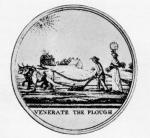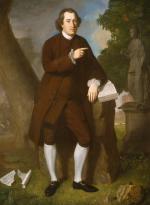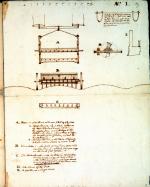![header=[Marker Text] body=[The noted agriculturalist purchased land just north of here in 1792 and named it "Como Farm". Here, he conducted numerous experiments on crop rotation and maintenance of soil fertility. Bordley planned new devices for seeding and reaping wheat. His works on Rotation of Crops, and Husbandry and Rural Affairs were widely read. Died, 1804. ] sign](http://explorepahistory.com/kora/files/1/10/1-A-34-139-ExplorePAHistory-a0a5e1-a_450.gif)
Mouse over for marker text
Name:
John Beale Bordley
Region:
Philadelphia and its Countryside/Lehigh Valley
County:
Chester
Marker Location:
SR 3062 (Strasburg Rd.) just off PA 162, 1.6 miles W of Marshalltown
Dedication Date:
March 25, 1953
Behind the Marker
With land plentiful and labor dear, many Pennsylvania farmers in the eighteenth century mined the soil, cropping until the nutrients were depleted, then moved on. Using tools little changed since the days of the ancient Romans, farmers were a conservative lot whose knowledge of agriculture had been passed down from one generation to the next.
One of Benjamin Franklin's objectives in founding the American Philosophical Society in 1744 was to apply science to the improvement of agriculture In the mid 1700s, a time when England was undergoing rapid agricultural advances. Not to be left behind, a group of American gentlemen engaged in the "learned professions" decided to form a society like those found in England to "promote a greater increase in the products of the land."
On February 11, 1785, twenty-three of these men, including Founding Fathers James Wilson,
James Wilson,  Benjamin Rush, Robert Morris, and other prominent Philadelphians, met at Patrick Byrne's Tavern in Philadelphia to form the Philadelphia Society for Promoting Agriculture (PSPA).
Benjamin Rush, Robert Morris, and other prominent Philadelphians, met at Patrick Byrne's Tavern in Philadelphia to form the Philadelphia Society for Promoting Agriculture (PSPA).
Later that year Benjamin Franklin and
Benjamin Franklin and  Thomas Paine joined the association. The guiding spirit behind the Society was Judge John Beale Bordley. A gentleman farmer and ardent agricultural reformer, Bordley used the PSPA to promote crop rotation, soil enrichment, and the use of
Thomas Paine joined the association. The guiding spirit behind the Society was Judge John Beale Bordley. A gentleman farmer and ardent agricultural reformer, Bordley used the PSPA to promote crop rotation, soil enrichment, and the use of  labor- and time-saving devices.
labor- and time-saving devices.
Born in Annapolis, Maryland on February 11, 1727, John Beale Bordley became a successful lawyer and Baltimore judge. In 1770, he bought Pool's Island near Joppa and a 1,600-acre farm on an island in the Wye River, where he made his home. Convinced that American farming could be significantly improved, Bordley studied the works of leading British experts and experimented with different agricultural methods on his Wye Island plantation. He was critical of many common farming practices, especially repeated plantings of crops that were "heavy feeders" (meaning they drew great quantities of nutrients from the soil) in the same fields year after year without enriching the ground, which brought low yields and significantly deteriorated the soil's quality.
Based on his experiences, Bordley urged farmers to embark on a system of frequent crop rotation in which fields planted in corn, grains, or tobacco one year were sown with a beneficial cover crop of beans, clover, or peas in the following year. He devised an eight-year crop rotation scheme that had three years of clover plantings to restore some of the soil's fertility.
Judge Bordley also encouraged fellow agriculturalists to apply manure to their fields as a way to improve the soil. He also used new agricultural equipment, designed devices himself to plant wheat in clusters, to sow clover seed, and to weed between rows, and shared the findings of his experiments in print, publishing A Summary View of the Courses of Crops, in the Husbandry of England and Maryland in 1784.
In 1791, Judge Bordley and his wife Sarah moved to Pennsylvania, where they kept a house in Philadelphia and a large farm in Chester County. On his "Como Farm," Bordley established one of the first model farms in the country, and there conducted many of his agricultural experiments.
Here, too, Bordley wrote books on his research: Sketches on Rotations of Crops and other Rural Matters published in 1797, and his most extensive and most popular work, Essays and Notes on Husbandry and Rural Affairs, which first appeared in 1799. John Beale Bordley died on January 26, 1804, and was buried in the family vault at St. Anne's Episcopal Church in Annapolis, Maryland.
Essays and Notes on Husbandry and Rural Affairs, which first appeared in 1799. John Beale Bordley died on January 26, 1804, and was buried in the family vault at St. Anne's Episcopal Church in Annapolis, Maryland.
In the late 1700s, the Philadelphia Society for the Promotion of Agriculture published papers, offered premiums for agricultural accomplishments, and lobbied for the creation of similar organizations in the state. They also funded and constructed the first permanent bridge across the Schuylkill River, that, when completed in 1804, was the longest covered bridge in the world. This bridge enabled farmers in Chester and Lancaster counties to more easily transport their produce to Philadelphia's markets.
After a lapse of activity in early 1800s, a revived PSPA became one of the nation's most active and important agricultural groups, and effectively promoted agricultural improvements in the Commonwealth. Today, the Philadelphia Society for Promoting Agriculture remains a vibrant organization.
"The better courses of crops are founded in these principles: to fallow and to have growing on the fallow, while it is yet under the plow or hoe, a shading and ameliorating or mild crop, as peas or beans; never to sow any sort of corn [any grain] immediately after corn of any kind; to sow clover or an equivalent on every field of small grain; and to prevent the soil of the shaded fallows from resting, hardening and running into weeds."
-Judge Bordley, Sketches on Rotation of Crops, 1792.
With land plentiful and labor dear, many Pennsylvania farmers in the eighteenth century mined the soil, cropping until the nutrients were depleted, then moved on. Using tools little changed since the days of the ancient Romans, farmers were a conservative lot whose knowledge of agriculture had been passed down from one generation to the next.
One of Benjamin Franklin's objectives in founding the American Philosophical Society in 1744 was to apply science to the improvement of agriculture In the mid 1700s, a time when England was undergoing rapid agricultural advances. Not to be left behind, a group of American gentlemen engaged in the "learned professions" decided to form a society like those found in England to "promote a greater increase in the products of the land."
On February 11, 1785, twenty-three of these men, including Founding Fathers
Later that year
Born in Annapolis, Maryland on February 11, 1727, John Beale Bordley became a successful lawyer and Baltimore judge. In 1770, he bought Pool's Island near Joppa and a 1,600-acre farm on an island in the Wye River, where he made his home. Convinced that American farming could be significantly improved, Bordley studied the works of leading British experts and experimented with different agricultural methods on his Wye Island plantation. He was critical of many common farming practices, especially repeated plantings of crops that were "heavy feeders" (meaning they drew great quantities of nutrients from the soil) in the same fields year after year without enriching the ground, which brought low yields and significantly deteriorated the soil's quality.
Based on his experiences, Bordley urged farmers to embark on a system of frequent crop rotation in which fields planted in corn, grains, or tobacco one year were sown with a beneficial cover crop of beans, clover, or peas in the following year. He devised an eight-year crop rotation scheme that had three years of clover plantings to restore some of the soil's fertility.
Judge Bordley also encouraged fellow agriculturalists to apply manure to their fields as a way to improve the soil. He also used new agricultural equipment, designed devices himself to plant wheat in clusters, to sow clover seed, and to weed between rows, and shared the findings of his experiments in print, publishing A Summary View of the Courses of Crops, in the Husbandry of England and Maryland in 1784.
In 1791, Judge Bordley and his wife Sarah moved to Pennsylvania, where they kept a house in Philadelphia and a large farm in Chester County. On his "Como Farm," Bordley established one of the first model farms in the country, and there conducted many of his agricultural experiments.
Here, too, Bordley wrote books on his research: Sketches on Rotations of Crops and other Rural Matters published in 1797, and his most extensive and most popular work,
In the late 1700s, the Philadelphia Society for the Promotion of Agriculture published papers, offered premiums for agricultural accomplishments, and lobbied for the creation of similar organizations in the state. They also funded and constructed the first permanent bridge across the Schuylkill River, that, when completed in 1804, was the longest covered bridge in the world. This bridge enabled farmers in Chester and Lancaster counties to more easily transport their produce to Philadelphia's markets.
After a lapse of activity in early 1800s, a revived PSPA became one of the nation's most active and important agricultural groups, and effectively promoted agricultural improvements in the Commonwealth. Today, the Philadelphia Society for Promoting Agriculture remains a vibrant organization.
Beyond the Marker







